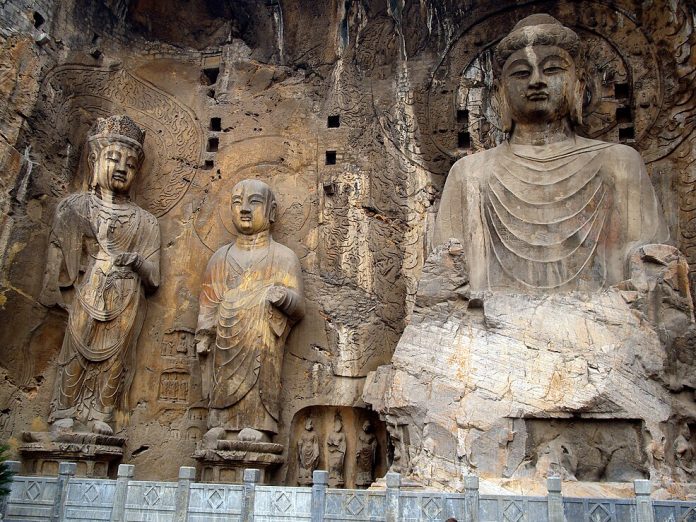As China pushes forward with its efforts to establish a Chinese variant of Buddhism, it attempts to stake a claim on the very origins of the religion. However, for millions of Buddhists across the world, the history of Buddhism’s birth in India remains untouchable. “India will always be the centre of Buddhism for us—the place where the Buddha attained enlightenment,” says Tswewang Dorzi, a Tibetan Buddhist scholar from Dharamshala. Dorzi’s conviction underscores the deep spiritual and historical connection that Buddhists have with India, where the roots of their faith lie.
But does this mean that China’s attempts to Sinify Buddhism are doomed to fail? “Perhaps,” says Dorzi, though he acknowledges that the Chinese campaign to reshape the religion’s narrative is relentless. He highlights how India’s legacy in the growth of Buddhism, particularly through figures like Padmasambhava, or Guru Rinpoche, is inseparable from the religion itself. Known in Tibetan as Slob-dpon (Teacher) or Padma ‘Byung-gnas (Lotus Born), Padmasambhava’s influence stretches across the high Himalayas. His teachings have deeply resonated with communities in the region known as Monyul, which extends from the Tibetan plateau into India. These communities, largely followers of Tibetan Buddhism, have preserved the spiritual traditions connected to the great guru.
Dorzi points out that the Eastern Himalayas, spanning regions under the jurisdiction of Nepal, India, Bhutan, and China (Tibet), are home to a rich diversity of communities, each with their own religious practices, including Tibetan Buddhism. Scholars have long explored how Padmasambhava spread Vajrayana, or Tantric Buddhism, across these regions, cementing India’s connection to this spiritual path. Professor Jigme Yeshe Lama of the Kolkata University, for instance, writes about how Padmasambhava, an Indian tantric adept born in the Swat Valley—modern-day Pakistan—brought Vajrayana Buddhism to Tibet and founded the Nyingmapa school. “This history is unchangeable,” Dorzi affirms, calling out the Chinese government for its hypocrisy in attempting to stake a claim on Padmasambhava’s legacy.
China’s efforts to control the narrative of Buddhism, particularly Tibetan Buddhism, have included acts of destruction aimed at erasing the tangible symbols of this heritage. According to reports in Free Tibet in January 2022, Chinese authorities in Drago County demolished a 45-foot bronze statue of Padmasambhava, which stood outside Chanang Monastery in Nyimo Township. The report further adds that this act followed an earlier incident where a 99-foot Buddha statue in Sengdeng Village was similarly destroyed under the watch of paramilitary troops.
These acts of aggression are not isolated. As per reports coming out of Tibet in 2007, statues of Padmasambhava were targeted in Ngari Darchen, Burang County, and Kardze County, among other areas within Tibet. These demolitions, orchestrated by the People’s Liberation Army (PLA) under the command of the Chinese Communist Party (CCP), reflect a broader strategy to erase the teachings and influence of Padmasambhava, whose spiritual legacy challenges China’s narrative.
Despite these aggressive efforts, scholars like Dorzi and others insist that China’s actions cannot erase the rich history of Buddhism’s spread from India. Yet, China’s ambitions to become the global centre for Buddhism, through initiatives like Buddhist diplomacy, are seen as a potential disruptor. Dorzi notes that China has made significant inroads in countries such as Sri Lanka and throughout Southeast Asia, where they have formed alliances with Buddhist groups that are economically dependent on Beijing. “These relationships could shift the balance in China’s favour,” he warns.
The World Buddhist Forum: A political tool disguised as religious dialogue
One of China’s most prominent platforms for this strategy is the World Buddhist Forum (WBF), which is set to convene its sixth session in Ningbo this October. Although ostensibly a platform for spiritual exchange, the WBF is increasingly viewed as a vehicle for China’s political agenda. A Tibetan youth describes it as “an instrument of state control,” pointing out how the forum, under the guise of promoting world peace, is being used to advance the Sinification of Buddhism. Launched in 2006, the WBF has grown into the largest multilateral platform for Buddhist dialogue, yet its noble goals of peace and well-being are overshadowed by China’s deeper political motives.
The Chinese government’s narrative posits that Buddhism, particularly Tibetan Buddhism, is fundamentally Chinese. This attempt to rewrite history erases the contributions of other cultures, particularly India, which remains central to the origins of the religion. At a 2021 National Conference on religious affairs, Chinese President Xi Jinping emphasised the necessity for religions in China to embrace a distinctly Chinese character. This initiative is part of China’s broader agenda to mould Buddhism in line with the CCP’s political goals. Buddhism’s reputation as a doctrine of peace and non-violence makes it an appealing instrument for China’s diplomatic influence, particularly as it seeks to counter perceptions of secularism within the CCP.
China efforts at Sinification of Tibetan Buddhism which has gone beyond its borders has been excellently portrayed by a report in the Morung Express which highlights how Beijing has also been promoting sacred Buddhist sites and figures such as Avalokitesvara, Amitabha, and Manjushri to attract pilgrims and tourists. The report further adds that this effort includes replicating Buddhist holy sites in India, such as the Brahma Palace in Wuxi, which is designed to resemble Rajgir. Moreover, China has been backing the Shugden faction of the Gelug School, providing financial support such as in Bangladesh through initiatives like the annual Dipankar Atisha Peace Award. These actions are not limited to China’s borders; Nepal, Pakistan, and Bangladesh are all key targets of China’s Buddhist diplomacy.
In Pakistan, China has focused on promoting the Gandhara trail, which connects Buddhist sites in Pakistan to South Korea and Japan. According to reports China is actively positioning Pakistan as a key destination for Buddhist pilgrimage and a historical centre for international Buddhists.
The Sinification of Tibetan Buddhism: A threat to religious freedom
China’s manipulation of Buddhism is not merely an attempt to claim historical legitimacy; it is central to the CCP’s broader policy of Sinification. This policy seeks to reshape all aspects of religious life in China to align with the ideologies of the CCP. Tibetan Buddhism, with its deep cultural ties to Tibet, poses a direct challenge to this agenda. The CCP views Tibetan Buddhism’s influence as a threat to its control over the region and, by extension, to its authority. Consequently, efforts to co-opt and Sinify Tibetan Buddhism have intensified in recent years.
In March 2024, during China’s Two Sessions, Wang Huning, head of the Chinese People’s Political Consultative Conference (CPPCC), reaffirmed the importance Beijing’s attaches to promoting the Sinification of Tibetan Buddhism. This campaign, which has been ongoing since Xi Jinping’s announcement in 2012, is about stripping the religion of its unique characteristics and repurposing it as a tool of state control. The Buddhist Association of China (BAC), once a non-political organization, has now become a key instrument of this agenda, explicitly supporting the CCP’s directives to align religious practices with socialist principles and Xi Jinping Thought.
As the international Buddhist community gathers in Ningbo for the upcoming World Buddhist Forum, it is crucial to confront the reality of China’s attempts to rewrite Buddhism’s history. What should be a forum for spiritual growth and dialogue has become a tool for state propaganda. Failing to recognise this could result in the further erosion of religious freedom and the distortion of one of the world’s oldest and most profound religions.
China’s ambitions to reshape Buddhism for its own political gains may seem insidious, but the global Buddhist community remains steadfast in its reverence for the true origins of the faith. For all the CCP’s efforts to promote China as the seat of Buddhism, the world’s Buddhists continue to look to India as the birthplace of their religion. Sites such as Bodh Gaya, Sarnath, and Nalanda hold spiritual significance that no state-sponsored narrative can erase. In the end, China’s efforts to rewrite the history of Buddhism may disrupt the present, but they cannot erase the indelible link between Buddhism and its true origins—the forgotten story of India’s enduring role in the religion’s past, present, and future.







































